#yarok
Explore tagged Tumblr posts
Text
MTG is such a good game bc I can play like 4 cards and summon 486 bugs in a single turn 🪲🪲🪲🪲🪲🪲🪲🪲🪲🪲🪲🪲🪲🪲🪲🪲🪲🪲🪲🪲🪲🪲🪲🪲🪲
#scute swarm + yarok the desecrated + panharmonicon + a couple cards that allow me to play extra lands + 2 land drops and a rampant growth#things that make you feel like an insectomancer#mtg#mtg commander#lichen thoughts
1 note
·
View note
Note
Can you teach me any fun Israeli stoner slang?
I'm not a stoner, but imma do the best with what I know
Puff - Shachtah שאכטה
Green - Yarok ירוק (weed)
Shell - Pagaz פגז (weed)
Satla - סטלה (the high, the feeling of being stoned)
Stoner - Satlan סטלן
Faisel - פייסל (a weed cigarette)
Israeli stoners are welcome to add more XD
24 notes
·
View notes
Text
Flavor Text Highlights - Magic 2020
<- Previous Set | Next Set ->
Cool - Show of Valor
“As the knight struggled to stand, his squire took up his blade. The foe advanced not a single step.” —Krinnea, Siege of the Bone Spire

Funny - Pattern Matcher
“Good! Now put it with the other widdle bunnies.” —Sargis Haz, artificer

Worldbuilding - The Lament for Bala Ged Cycle
“Yarok grieves within the waste Of Bala Ged’s corrupted land.”
“Yarok’s waters rush and rage Where armies bled into the sand.”
“Yarok’s nightmares lurk and wait Where dark despair is near at hand.”
“Grief and rage and nightmares fade Where hope and comfort make their stand.” —Lament for Bala Ged




Emotional - Tale's End
“When you are gone, will anyone remember your story?” —Unknown

<- Previous Set | Next Set ->
58 notes
·
View notes
Text

Yarok the Desecrated - Predator alter
9 notes
·
View notes
Text
Life is Strange EDH/Commander headcanons: True Colors Edition
AN: Not a lot of canon stretching for this one really. I can totally see Steph trying to organize a Haven commander pod and roping Alex and a reluctant Ryan into the fray.

Alex Chen:
Has an incredibly cheese filled Jodah, Archmage list. While she and Steph snicker about the the thematic relevance of Jodah's emphasis on colors, what really attracts Alex is the fact that she can throw around huge, game-swinging spells at a steep, steep discount.
Absolutely uses her powers to read the other players at the table. If you feel sad and internally lament being mana-screwed, get ready to be targeted. If you're excited and getting ready to swing out for lethal or are on the verge of assembling your combo, don't be surprised if Alex suddenly starts politicking with the table to put you down.
On the topic of her own emotions, she will either be the picture of stoicism or a salty little gremlin who lets grudges run deep throughout the night. It really depends on the group, but God forbid if Ryan even swing at her with something as innocuous as a 2/2 squirrel token, you're all in for it.
Doesn't really like creature centric decks and when she does, they're usually being played in service of some other goal. Instead she values high interaction but utterly bullshit lists like Yarok landfall and Prosper tax fraud treasure, much to Steph's chagrin.

Ryan Lucan:
Kinda like Nathan in the previous installment of this series, Ryan is another case of someone who would really let the in-universe color philosophy affect their out of game choice of commander.
He LOVES the entire concept behind mono-green and endures Steph clowning on him for it because he knows that Birthing Pod and Craterhoof Behemoth do not give a fuck what she has to say when it comes time to shuffle up.
Really enjoys playing ramp heavy stompy decks like Selvala. The more creatures he can shit out, the better.
You already know he has a bird tribal deck too. He started out with Derevi, but splurged immediately and wheeled it into a Falco Spara, Pactweaver list once New Capenna dropped because it combines his love of avian stuff and cheating creatures out.
Alex constantly harangues him about how he never optimizes, but to be honest, it's already pretty serviceable at the Haven Commander Night's power level. There's just something about removing a counter off Soulcatcher and in order to flash out Aven Mindcensor that soothes Ryan's soul.

Steph Gingrich:
Oh Steph, where do we begin? Nerd queen supreme over here definitely makes routine trips into Denver to LGSs to pick up singles or just oogle fetch lands and art prints.
Isn't actually all that into Magic because she prefers more narrative driven modes of play like TTRPGs and LARPing, but will def throw down especially if it means she could school Ryan and Alex.
Once the AFR set dropped, Steph was suddenly ALL over organizing commander nights.
Once she got everyone together, she proceeded to debut a hum-dinger of a Captain N'ghathrod list much to the chagrin of pretty much fucking everybody in attendance (especially Ryan. Poor guy probably had to watch HER play more of his deck than he did lol).
I am 100% convinced every move she makes in-game would just be a subtle way of trying to flirt with Alex, which is both a great boon to those who can figure that out and a curse when it comes to making deals.
#life is strange#life is strange true colors#steph gingrich#alex chen#ryan lucan#tl;dr they just use mtg as a medium of bullying Ryan lol
3 notes
·
View notes
Note
FMK?
Yomiji, Who Bars the Way
Yargle, Glutton of Urborg
Yarok, the Desecrated
Fuck Yargle, gotta respect the Yarg-heads out there even if I don't feel anything for him
Marry Yarok, it seems super nice and like a good nightmare
Kill Yomiji
7 notes
·
View notes
Text
Limited Experiences, Archetypes, and How a Little Madness will Get You Nowhere or Everywhere
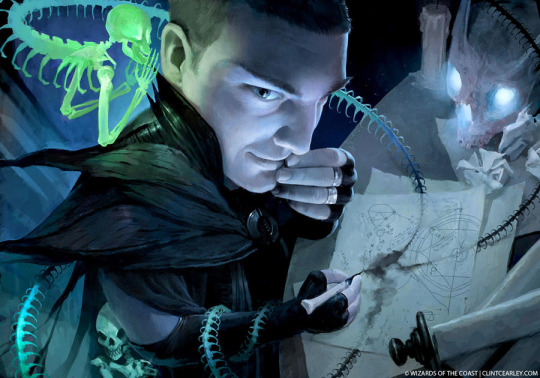
Folks, I don't play Arena and I don't have a MODO account. I've drawn tokens and borrowed dice. My experiences in MTG have been weird to say the least and I've been playing since before I needed to shave regularly. Which I still don't.
But part of Magic's versatility is the ability to go hog wild with the card that you pick as long as you're doing something fun. I draft a lot with my students when we can, and I get to see the kinds of decks that they play as well. Back in Shadows over Innistrad, I was fascinated with a student's Jeskai Aggro build; he's still playing at the LGS whenever he can, with a real job and everything. When we drafted Streets of New Capenna, one student played BW Elspeth and another swung Temur, of all things. You don't have to be normal about anything.
I'm far from normal in my constructed designs, so I'll admit to being caught by the bug; my competitive Pioneer decks are a homebrew Mono-White Weenies deck that still runs Brimaz, and a Mono-Red Skredless Skred Karnfires pile of nonsense that baffles the Spikes right before they beat me (or get Glorybringer'd). And yet, when I draft, normalcy abounds. The big cards are big, and the other cards are... Well, sometimes control works. Sometimes.
I'm going to go through the four most recent standard sets and talk about their archetypes, my experiences, and whether or not weirdness is permitted. Hopefully this will encourage you to go back and find a bit of weirdness yourself. Or not. But whatever you make for this week, it has to capture something that'll make us feel again. Don't let me down—but how can you? You're an Inventor.
Let's start most recently...
MARCH OF THE MACHINE
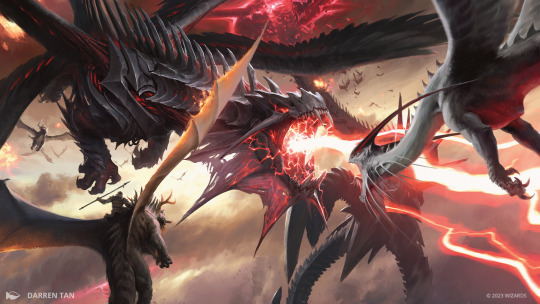
As many folks have heard me crow about already, I won our LGS's March of the Machine store championship. The deck was greedy, swingy, and the legends really tore the deck apart with their power level. Elesh Norn, Grand Cenobite was and is a very powerful card. The limited archetypes were:
WU Knights
UB Instants/Sorceries/Recursion
BR Sacrifice
RG Battles
GW +1/+1 Counters
WB Incubate/Phyrexians
BG Incubate/Phyrexians
GU DFCs
UR Convoke
RW Backup
An abundance of mana-fixing ensured that the three/four/five-color decks could have fun on their own, and the wedge legends encouraged that as well if you could pick them up. The inclusion of Yarok and Atraxa were rare, but also pushed for a little bit of green-oriented power there.
As you can see, two archetypes (Battles & Backup) pushed for the newest set mechanics. Personally? I never tried them. Backup was best used wherever the aggro happened on its own, and Battles were better in the grindier colors and/or as bombs for other archetypes when necessary.
Grinding out fliers was usually the way to go. I don't have many fond memories of drafting this set, not in the same way I do with other sets. The mechanics were great, and Battles were surprisingly fun, but coming out on top felt less about who was the better player and more who could draw into the uninteractive over-the-top synergy first.
When things got good, things got GREAT. I stared down an amazing five-color Alara pile once that blew me out of the water, and knights had a heck of a time. But sealed... Sealed was amazing. Even the prerelease (which I missed winning by a hair) had amazing moments. The decks could pack all their iconic characteristics into one mashup and it felt like assembly of a monument, less haphazard and more genuinely epic. What does it say that a set feels more cohesive the less control you have over what you pick from it?
At least the Incubate mechanics were awesome all around. It synergized with Phyrexian typal, +1/+1 counters, and the transformation theme. I'd put Incubate as my favorite mechanic and archetype.
WEIRDNESS CONCLUSION: You had to get weird with this format, but even the weirdness didn't feel good because the biggest cards like Ghalta and Chandra performed regardless of their archetype. It was both cluttered and samey at the same time. Weirdness failed to find the good-feeling spot.
Best you could do was the five-color pile, and that relied on bomb support—not that you really had to ask for it.

PHYREXIA: ALL WILL BE ONE

This set was baller. It was fast. It was fun. It was interactive on the battlefield. Combat mattered immensely and topdecks felt radically tense. I had so much fun with this set. The archetypes were:
WU Artifacts Matter
UB Proliferate
BR Oil Sacrifice
RG Oil Aggro
GW Toxic Midrange
WB Mites/Tokens
BG Toxic Aggro
GU Proliferate
UR Noncreatures
RW Equipment
Out of all of these, the only archetype I saw eschewed was GW. My favorite deck I made was a four-color pile with Atraxa (hnnng, yet 2-1 overall) but I saw mono-red go undefeated one night as well. Two proliferate and two toxic archetypes meant there was a fair amount of love to be spread, yeah? But speed mattered a lot. Usually.
There was a night where I had the fastest BG deck possible, and only dropped a game where I missed four land drops in a row. But I won the match because the proliferation mattered when the toxic couldn't connect, and there was no way out. Battles were furious. People say that RB was the best archetype—or was it RG?—but just about everything could be done well. WU wasn't the most popular, and neither was UB, but both of them performed well.
Oil counters being the newest addition as do-nothing-but-synergize felt a little off at first, but when they worked, they worked immensely well, and they suited the environment in a way that I really didn't expect. You wanted to get them, use them, board them, and burn them. And don't get me started on the awesomeness of For Mirrodin! As a piece of noncreature-ish tech, the equipment archetype was more powerful than I had thought possible.
WEIRDNESS CONCLUSION: If you could do it right, you could do it well. 3-5 color decks had odd synergies but had stiff competition. This set didn't feel like it had quite the wiggle room for competitive oddities, but it felt good to perform with them all the same. Cunning mattered more.
Best you could do would probably be a control curve. A lack of sweepers meant true control was next to impossible, but you could eke it out.

THE BROTHER'S WAR

Out of all the disappointments, BRO was one of the most frustrating to contend with. Big stuff on top of big stuff only mattered when you could cheat it out or go fast enough that it hardly made a difference when you killed someone. Forgone conclusions were just that. The archetypes were:
WU Soldiers
UB "Draw Two"
BR Sacrifice
RG Powerstone Aggro
GW Artifact ETB
WB Small Soldiers
BG Self-Mill
GU Big Robots
UR Noncreatures
RW Aggro
Go fast or go home. When games got grindy, everyone went to time, and then everyone who drafted red got to sit around and watch them before winning the event. There were, on occasion, odd decks that managed to eke out victories, but the archetypes felt more or less directionless.
Soldiers had to be committed to so early that, if you didn't draw a bomb P1P1, you were done for. Powerstones felt good and versatile all around, but they were primarily sacrifice fodder and on occasion used in combat for tricks that would get lethal anyway. People would hate out the RB deck for that alone, and then whoever got the red bombs or the ramp would come out on top. Removal felt decent. Blue was a strange fiend where practically none of the archetypes felt supported, but WU worked if you just went for straight midrange. Urza's rare card in particular was stellar.
Drafting a curve was useless unless you built specifically to go against the decks that were going faster than you. The bonus sheet as well was...interesting. Quicksilver Amulet was particularly strong if you could find it. But even Wurmcoil Engine was slow. Sometimes you got to go nuts with Bone Saw. Most often, they slotted in, but didn't change much unless they hit the other singularly good card in your deck.
WEIRDNESS CONCLUSION: I watched my Students play with this one. One of them assembled the Workers in his deck and only lost one match. But RG aggro got there because the kids drafting RB weren't quite ready to go nuts. I was surprised at some of the expertise and not at all surprised at the others. With the LGS, nobody particularly liked the set because of the imbalance.
Best you could do probably WOULD be the Workers deck, unless you had some kind of combo. To get true jank, you'd have to board specifically against the best decks.

DOMINARIA UNITED
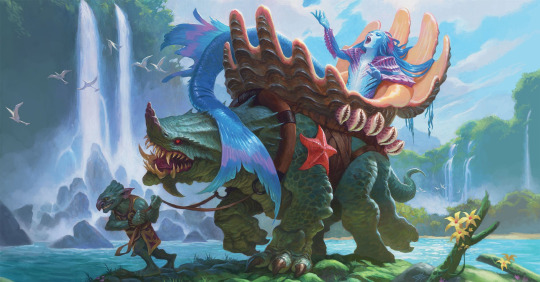
This is how you can make weirdness work. You know how in Khans of Tarkir, the lifegain lands made all the difference? But in March of the Machine, they muddled the waters? Well... Anyway, here are the archetypes:
WU Instants/Sorcery Midrange
UB Instant/Sorcery Control
BR Death/Sacrifice Aggro
RG Domain Beats
GW Tokens
WB Aristocrats
BG Graveyard Matters
GU Domain Ramp
UR Instant/Sorcery Aggro
RW Enlist Aggro
Fast and furious? It would seem so, but there was enough countermagic, removal, and interruption in this set to give it a strong back-and-forth. Even lifegain mattered immensely! My favorite deck I made was an incredible Sultai control build, but I got blown out on other nights with other fantastic decks, and in general? We had so much fun trying to be weird. That Sultai deck was splashing for the Domain lands, and that's where the fun happened.
The aggro was often offset by the other colors having big durdly butts and toughness that could match it, plus draw power on the side. Splashing was vital unless your game plan was tuned precisely. Equipment mattered, and every draw got you closer. Searching was fun and made for difficult choices. Domain was always relevant, always.
In every color combination, you could make something relevant, and if things went wrong, that was okay. Off-color kicker still felt great to build a powerful deck around. Removal felt like it had to be used at the right time, and it could turn the tide of battle with effort yet. Sometimes white felt a little weak, until it flew through the air and smacked the crap out of you. And if someone got a solid defenders deck, they were on cloud nine.
The format allowed for decks to slow down the field enough for interaction to happen, and the fast decks got their day in the sun all the time. Balance and options without too many cards and without a push towards bombastic setpieces meant that synergy could prosper. Yes, even with Sheoldred in the set.
WEIRDNESS FACTOR: If you could dream it, you could do it. The set punished spreading yourself too thin without support, but the support that it gave allowed for weird stuff to manifest quite well.
There's no limit to the best you could do: Abzan sacrifice, five-color goodstuff, Legendary typal, Jeskai spellslinging (that happened a fair amount actually), Bant control... It was awesome.

But these were just my experiences and my observations. On Arena, the same draft rules hardly apply. On MODO, the player base is much different. And of course, every LGS has its player base who plays differently.
What were your best limited experiences? What's the set where you felt the most powerful weirdness, and how do you want to bring that to your card this week?
With love, @abelzumi
10 notes
·
View notes
Text
downright dirty chicken arayes in homemade flatbread with schug yarok
2 notes
·
View notes
Text
32 Challenge
⚪🔵⚫🔴🟢 Codie and the Maze - Codie, Vociferous Codex
⚪🔵⚫🔴 Yore-Tiller's Tactician - Sophina, Spearsage Deserter & Cecily, Haunted Mage
🔵⚫🔴🟢 Double Dragon - Yidris, Maelstrom Wielder
⚫🔴🟢⚪ Revolving Graveyard - Elmar, Ulvenwald Informant & Wernog, Rider's Chaplain
🔴🟢⚪🔵 Artifactual Resurrection - Othelm, Sigardian Outcast & Bjorna, Nightfall Alchemist
🟢⚪🔵⚫ Storytime with Atraxa - Atraxa, Praetors' Voice
⚪🔵⚫ Toluz's Discarded Recycling Center - Toluz, Clever Conductor
🔵⚫🔴 Sol'Kanar's Aikido Dojo - Sol'Kanar the Tainted
⚫🔴🟢 Mutant Adventures - Mr. Orfeo, the Boulder
🔴🟢⚪ Electric Garden Party - Jetmir, Nexus of Revels
🟢⚪🔵 Defensive Strategy - Arcades, the Strategist
⚪⚫🟢 Yoshimaru, Ever Faithful & Reyhan, Last of the Abzan
🔵🔴⚪ Kykar, Wind's Fury
⚫🟢🔵 Yarok. the Desecrated
🔴⚪⚫ Edgar Markov
🟢🔵🔴 Illuna, Apex of Wishes
⚪🔵 Inscrutable Flight - Isperia the Inscrutable
🔵⚫ Ninja Power - Satoru Umezawa
⚫🔴 Lord Rakdos' Casino - Rakdos, the Showstopper
🔴🟢 Falling Rock - Mina and Denn, Wildborn
🟢⚪ Boar-ing - Yasharn, Implacable Earth
⚪⚫ Ayli & Lurrus, Zulaport Region Gymleader - Ayli, Eternal Pilgrim
🔵🔴 Arcane Astrology - Vadrik, Astral Archmage
⚫🟢 Veiled Greatness - Virtus the Veiled & Gorm the Great
🔴⚪ Field Studies - Osgir, the Reconstructor
🟢🔵 Volo's Bestiary - Volo, Guide to Monsters
⚪ Holier than Thou -Giada, Font of Hope
🔵 Book Smart - Gadwick, the Wizened
⚫ oh RATS! - Marrow-Gnawer
🔴 THUNDER - Toralf, God of Fury
🟢 Kosei, Drip Master - Kosei, Penitent Warlord
🔶 Mechanized Energy - Liberator, Urza's Battlethopter
0 notes
Text
Yarok, o Profanado/ Yarok, the Desecrated

Tipo de criatura: Elemental Horror
Custo de mana: 1 preta + 1 verde + 1 azul + 2 de qualquer cor = 5 no total
3/5 de Poder e Resistência
Por que ela é interessante? Essa criatura tem Toque Mortífero (não importa a resistência, qualquer criatura que defender o ataque dela irá morrer) e vínculo com a vida (ela cura pontos de vida iguais ao poder dela sempre que atacar com ela). Se uma permanente que entrar no campo de batalha fizer com que uma habilidade desencadeada de uma permanente que você controla seja desencadeada, graças a essa criatura, ela desencadeará uma vez adicional. Então TUDO que for desencadeado ao entrar no campo passa a ser desencadeado duas vezes.
Preço da carta: em torno de 9,50 até 260,00
Disponível em Português
"Essa carta tem algumas edições disponíveis, o preço pode variar a depender da edição que escolher adquirir"
Link: https://www.ligamagic.com.br/?view=cards%2Fsearch&card=Yarok%2C+the+desecrated&tipo=1
Até a próxima postagem, Ulli e Thiago
0 notes
Text

A Fungus Snail with a similar ETB effect as Yarok's Fenlurker. Too bad it doesn't have Fenlurker's second ability. However, it is better than Brain Maggot's ability since the exiled card stays exiled.
#mtg#magic the gathering#lost caverns of ixalan#preview season#fantasy card game#wotc#wizards of the coast
0 notes
Text
I would like to note that pretty much all of the names of these dishes are just Hebrew:
This is the exception. Plomeek is a Vulcan canonical plant.
Keekar Yarok means green loaf.
Tabsheel means a cooked dish.
Another exception although it does sound like the word for green or vegetable (yarok/yerek).
Shumar just means fennel.
Not only is braided egg bread just Challah but tzamah tanoor means oven braid.
Khabitah means omelette.
Ha Rageel just means "the regular."
Perach Kisan is basically an ungrammatical way of saying fruit dumpling or fruit in a dough pocket.

From Official Star Trek Cooking Manual compiled by Mary Ann Piccard from the logbook of nurse Christine Chapel
All of Mr Spock's favourite food
Recipes under read more
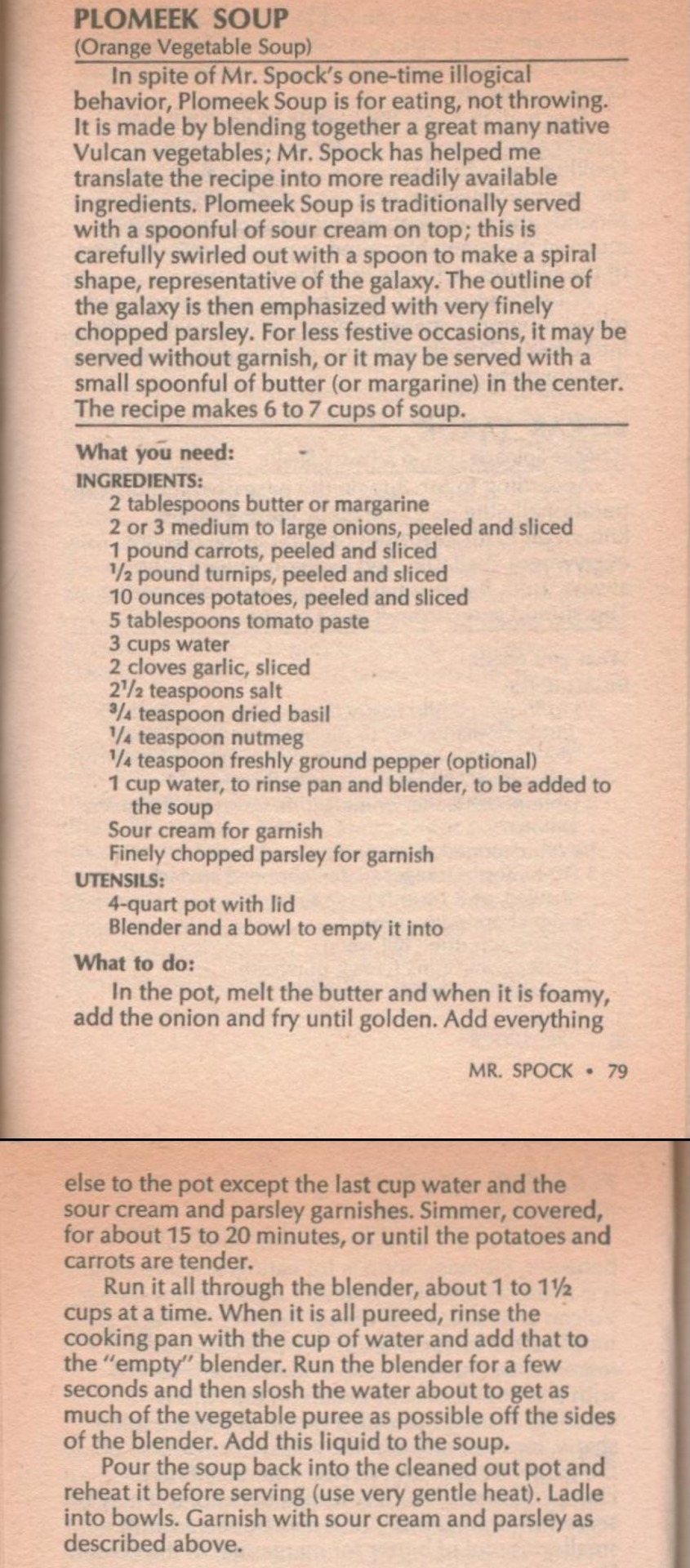





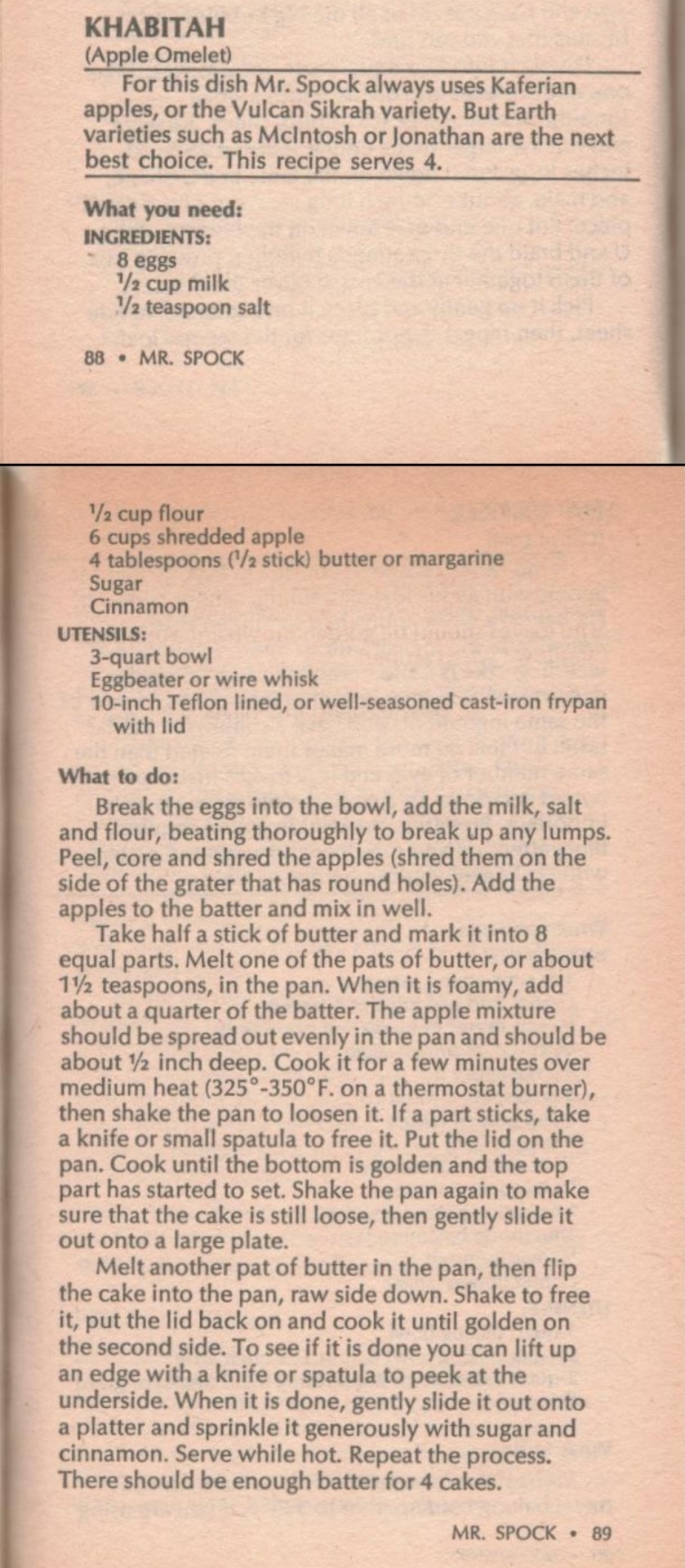
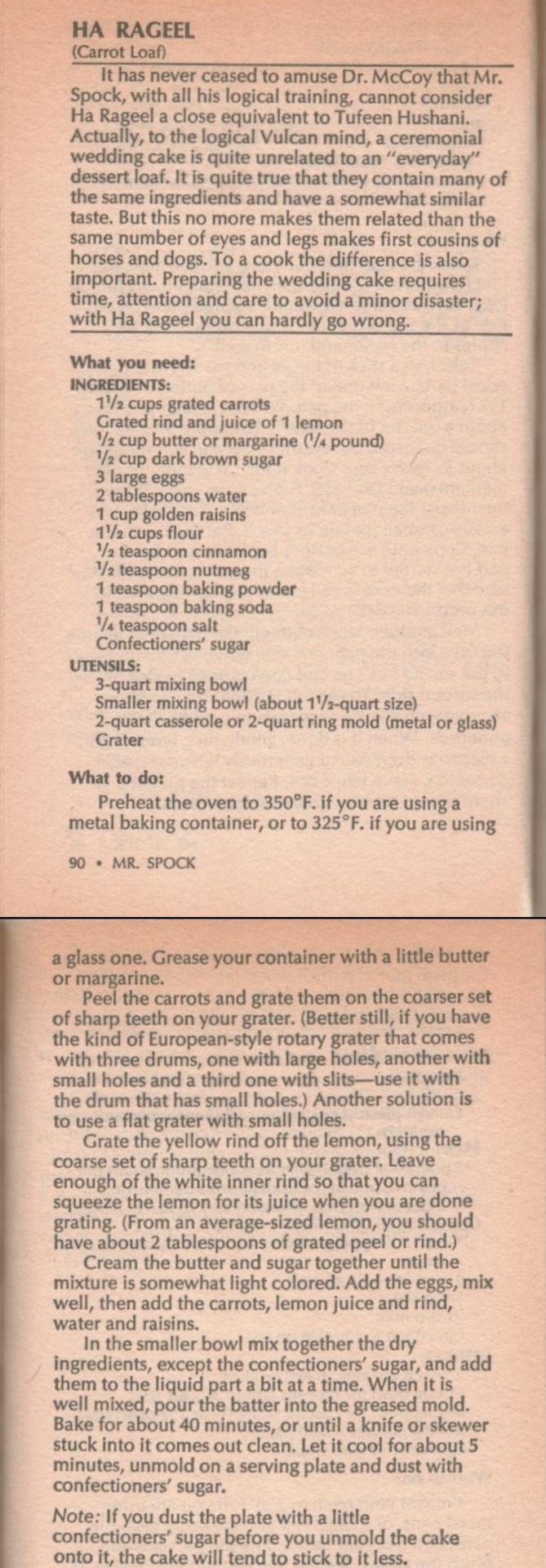
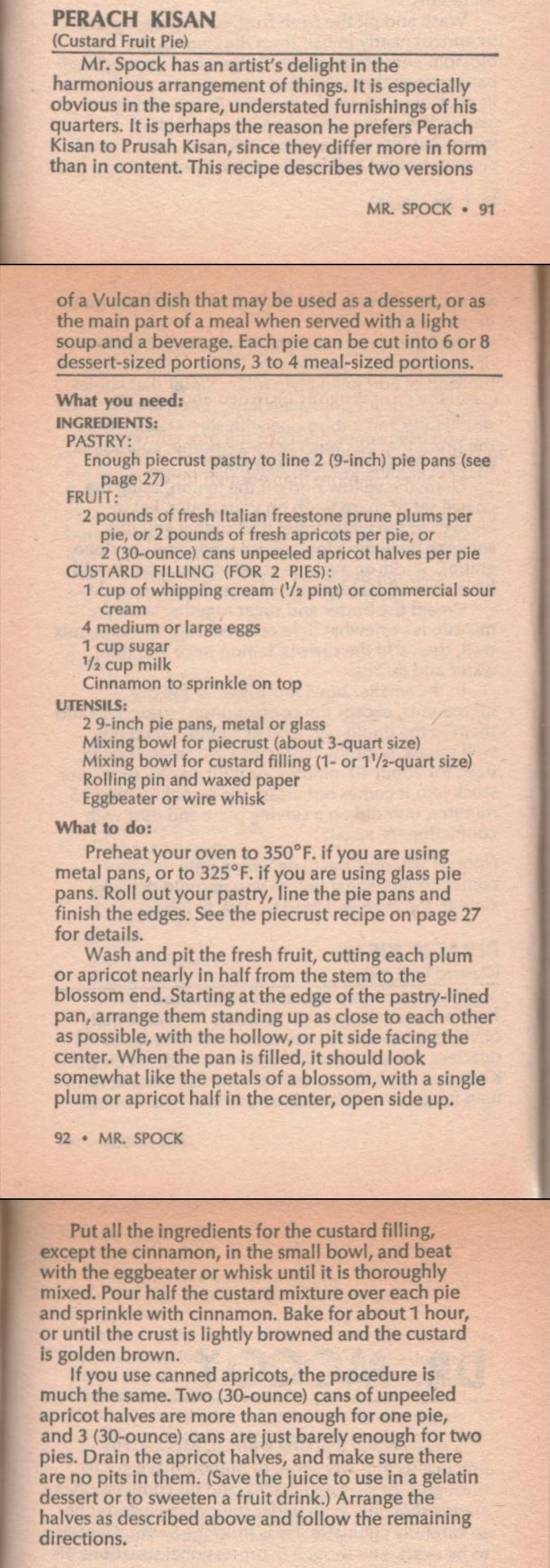
1K notes
·
View notes
Text
1 Kings 4: 7-19. "Driving the Camels."

The Hebrew word for month is yarok, "To transfer the light of the greater being to the lesser and 'bear it along'.":
ירה ירא
The forms ירה (yrh) and ירא (yr') are officially unrelated but their basic mechanisms appear to overlap somewhat. Both reflect an exchange of energy from a higher, dispensing level to a lower, receiving level. It appears that the form ירה (yrh) mostly describes the sending of the energy; either the exchange viewed from the perspective of the dispensing side, or else the shock-free absorption of the energy on the receiving side. The form ירא (yr') appears to deal mostly with the receiving of the energy; the exchange viewed from the perspective of the receiving side, and that usually with the anticipation of intense alteration.
+
ochlos (pronounced okh'los)
from a derivative of 2192 (meaning a vehicle); a throng (as borne along); by implication, the rabble; by extension, a class of people; figuratively, a riot:--company, multitude, number (of people), people, press.
Our first exposure to the transfer of energy from God the Sun to us the moon, one for each month was the 12 Tribes. Solomon added modifiers to these, except instead of naming them "Sons of Israel" they are "District Governors", whose jobs, "to supply provisions" according to the Midrash means they provide riddles, secret mathematical formulas, parables, and metaphors that embellish the literal meaning. All are needed if one is to succeed at the practice of Judaism.
The District Governors
7 Solomon had twelve district governors over all Israel, who supplied provisions for the king and the royal household. Each one had to provide supplies for one month in the year.
8 These are their names:
Ben-Hur—in the hill country of Ephraim;
"The Son of a Free House, which resides at the cutting edge of new technology."
9 Ben-Deker—in Makaz, Shaalbim, Beth Shemesh and Elon Bethhanan;
Ben Deker- son of the spear, meaning someone who resides under a constitution, with the aim being "ambitious hope" [Makaz].
Beth Shemesh= shared sovereignty with the Sun, the Creator
= Bayit
In the larger economy, a house interacts with other houses. These interactions are governed by the אב (ab), or "father" and executed by the בנים (benim), or "sons": those people living in the house, irrespective of any biological relation with the אב (ab). The "sons" combined add up to אם ('em), which means both "mother" and "tribe".
+
שמש
The noun שמש (shemesh) is the Biblical word for sun. Many ancient societies recognized that the sun rules life on earth, but few understood that even the sun is a mere creature, also firmly subjected to the laws of nature and ultimately the unchallenged sovereignty of the Creator.
Elon Bethanan=to be gracious from everyone from the Pillar to the ignoramus.
10 Ben-Hesed—in Arubboth (Sokoh and all the land of Hepher were his);
Ben-Hesed in Arubboth="spontaneous kindness and fidelity especially for providing an escape."
Sokoh= from the ignorance of Eve's Hedge.

The root סכך (sakak) or שכך (sakak) speaks of the creation of a hedge of sorts from interwoven strands of sorts. It commonly describes how prickly branches interweave to create a defensive hedge to hide behind and to look intently out from. In a figurative sense it may describe any sort of protective thing that consists of many separate branches, and from which one looks out.
The Psalmist famously connected this verb to the formation of a human fetus (Psalm 139:13), but it also obviously links to human culture and science and technology at large.
Hepher=to expose the man and bury the beast.
חפר
The verb חפר (hapar) means to dig, both in order to unearth something and to burry something. Hence this verb may be used both to describe (1) a quest for something wanted, and (2) a quest to obscure something unwanted.
The latter usage appears to have evolved into its own verb, namely חפר (haper), to be ashamed, again both because (1) something secret was exposed or (2) something embarrassing is sought to be covered.
The noun חפרפרה (haparpara) describes a kind of animal, probably a mole.
11 Ben-Abinadab—in Naphoth Dor (he was married to Taphath daughter of Solomon);
= Son of a generous noble, who lived in the heights, distilled into "jewelry", from a habit instilled by Solomon.
נדב
The verb נדב (nadab) means to give, donate or volunteer, and by implication to be noble. From it derive the noun נדבה (nedaba), freewill offering, the noun and adjective נדיב (nadib), generous or noble, and the noun נדיבה (nediba), generous deed.
12 Baana son of Ahilud—in Taanach and Megiddo, and in all of Beth Shan next to Zarethan below Jezreel, from Beth Shan to Abel Meholah across to Jokmeam;
Baana=
Verb ענה ('ana I) means to answer, respond or correspond, and since in the old world time was considered a cycle, noun עת ('et) means time. Temporal adverb עתה ('atta) means now; adjective עתי ('itti) means timely or ready, and conjunction יען (ya'an) means on account of. Noun מענה (ma'aneh) means an answer and noun ענה ('ona) means cohabitation.
Ahilud=
ילד
The verb ילד (yalad) means to beget or bring forth — children by both biological parents but also citizens by "mother"-cities and "father"-kings and such — or to produce (things) or bring about (events).
Taanach=Tanakh
perpetual water of God's attributes
Megidoo=
גדד
The verb גדד (gadad) describes making an invasive cut, mostly in order to expose something valuable. Noun גדוד (gedud) may describe an invasive band of raiders, or more general: a cutting, a furrow. Noun גדודה (geduda) means a furrow or cutting. Noun גד (gad) appears to describe the exposed treasure and may be used to describe a physical fortune, plain luck or a state of felicity.
Beth Shan=House of Change
Verb שנן (shanan) means to sharpen, and sharpening is achieved by removing material by repeatedly stroking a blade against a whetstone. This verb is also used in the sense of sharpening a mind by repeating the same exercise. Noun שן (shen) means tooth. Noun שנינה (shenina) denotes a "sharp" word; a taunt.
Verb שנה (shana) means to change or create a difference — of one's mind, or one's clothes, and this mostly through repetition. Noun שנה (shana) means year.
Zarethan=to besiege, confine, and reform
Jezreel=Yah's agent of sowing
Abel Meholah=
בלל
The verb בלל (balal) means to mix something with oil, usually flour products, usually as ritualistic food preparation. The emphasis of this verb lies on saturation and overflowing: to fill something with oil until it can absorb no more and begins to reject an excess of oil. Noun בליל (belil) describes a very rich mix for animals to eat. Noun שבלול (shabbelul) describes a snail, or an animal that looks saturated with oil. Nouns תבל (tebel) describes sexually incompatible partners, and noun תבלל (teballul) tells of insoluble material that obstructs a person's eye.
יבל
The verb יבל (yabal) speaks mostly of a flowing along some course, which of course requires the bottom of the course to be saturated and reject any further absorption. Noun יבל (yabal) means water course or conduit, noun יובל (yubal) means stream and noun אובל ('ubal) means stream or river. Adjective יבל (yabbal) means suppurating (discharging pus from a wound). Noun יבול (yebul) denotes produce from the soil and noun בול (bul) means produce or outgrowth. Noun יובל (yobel) or יבל (yobel) describes "a carrier" or "a producer" or "something that drives a flow" (e.g. a trumpet, or the principle of Jubilee). Noun תבל (tebel) refers to the whole world-economy.
אבל
Verb אבל ('abel) is like the previous ones in that it describes a drive of liquid or semi-liquid elements along some collective course. It's often used to describe a collective mourning, which either happened in a procession or else contagious enough to drag others along. Nouns אבל ('ebel) and אבל ('abel) both mean mourning, but the latter is also the word for actual water stream or brook. In cognate languages this verb is used to describe the driving of camels.
Jokmeam=
13 Ben-Geber—in Ramoth Gilead (the settlements of Jair son of Manasseh in Gilead were his, as well as the region of Argob in Bashan and its sixty large walled cities with bronze gate bars);
Ben Geber=son of the "dude"
Ramoth Gilead= "The Apex Pomegranate Fountain that is Not Rotten."
Jair=the light diffuser
Manasseh in Gilead= "What is not evaporated fountains onward."
Argob=a sluice window
Bashan=Fertility EAST of the Jordan; the inexperienced half of Manasseh, the WEST being the domain of the experienced half
60 walled cities with bronze gate bars=
Gematria of 3146, גאדו , gado=
The masculine noun כידוד (kidod), possibly meaning spark, or else glow red hot. This noun occurs only in Job 41:11.
The masculine noun כדכד (kadkod), denoting a kind of gem, possibly a ruby (Ezekiel 27:16 and Isaiah 54:12 only)
Formally this conjunction או ('o) has nothing to do with the previous roots, but to the Hebrew mind, their two meanings are not that far apart. The particle לו (lu), for instance, denotes potentiality (if such then so) and desire.
=Through the 60 Gates emerges a Ruby, AKA Reuben, a leader. See Vayera.
14 Ahinadab son of Iddo—in Mahanaim;
Ahinadab=to give, volunteer or be generous
Iddo=
ידד
The root ידד (yadad) has to do with love, and that mostly in the affectionate, physical sense. Adjective ידיד (yadid) means beloved or lovely. Noun ידידות (yedidot) means love, as in "a song of love" and noun ידידות (yedidut), meaning love in the sense of beloved one.
Mahanaim= "to camp down, to drive one's spear into the flopping spot".

חנה
The verb חנה (hana) means to decline or camp down; to contract one's range of activities and settle in a secluded spot. Noun חנות (hanut) means cell. Noun מחנה (mahaneh) means camp, and noun תחנה (tahana) means encamping or encampment.
The odd one out is the noun חנית (hanit), which is one of a few words for spear. Why a word for spear derives from a verb that means to camp isn't clear, but perhaps a wandering warrior would thrust his spear into the ground to mark his flopping spot.
15 Ahimaaz—in Naphtali (he had married Basemath daughter of Solomon);
= to show, to tell, to make known that all men must struggle together to make the Balsam of Peace.
16 Baana son of Hushai—in Asher and in Aloth;
Baana= to follow the cycle
Hushai= Hasten like chaff in the wind
חשש
The verb חשש (hashash) means to hurry, or rather to be light-footed and hence quickly moved. Noun חשש (hashash) describes chaff, which proverbially is so light that a breath of wind carries it off swiftly.
Likewise, verb חוש (hush) means to hurry or hasten. Adverb חיש (hish) means quickly.
This verb חוש (hush) may also be used to mean to be agitated, worried or enjoyed. Although some dictionaries demand that this concerns a second, identical verb, it probably isn't and simply describes the situation that arises when people are "inspired" by either joy or fear, break composure and ride their emotions like chaff does wind.
Asher=happiness
Aloth=yoke people who act like children to the furnace
Root עלל ('alal) describes to go up, or to make to go up.
Verb עלל ('alal I) means to repeatedly deal harshly with someone lower or weaker. Noun עוללות ('olelot) means a gleaning and the denominative verb עלל ('alal) means to glean. Nouns עלילה ('alila), עליליה ('alilya), מעלל (ma'alal) and תעלולים (ta'alulim) describe acts of wantonness or repeated self-indulgence: acts of being spoiled.
Hence noun עולל ('olel) means child and the denominative verb עלל ('alal II) means to act like a child (Isaiah 3:12). Verb עלל ('alal III) means to insert or thrust in. Noun על ('ol) means yoke, and (rather grim) noun עליל ('alil) means furnace or crucible.
17 Jehoshaphat son of Paruah—in Issachar;
Jehoshaphat= to judge and rule religiously, to enforce the Ordinances
Paruah=the young heiffer
Issachar= grow the weak into socially competent beings using the Numbers
18 Shimei son of Ela—in Benjamin;
Shimei=to demonstrate understanding in front of others
Ela=to the Collective
The root אלל ('alal) predominantly describes a protruding or sticking out. This may be positive (when one leads a collective), neutral (when one is a tree), or negative (when one fails convention). The latter sense in particular describes foolishness, or at least a failure to live up to cognitive standards or common codes of conduct.
Benjamin= Son of intelligence
19 Geber son of Uri—in Gilead (the country of Sihon king of the Amorites and the country of Og king of Bashan). He was the only governor over the district.
Geber=the Prevailing Man
Uri=to flow the Fire
Gilead= the waters of the Fountain of Testimony
Sihon=the Library of Synthetic Wisdom
Amorites= gossipers
Og, the Devourer of Innocence
...
It is the job of Leading Man, the one with the Spear, the Top Agent according to the Constitution, to lead the others to an education in all that society requires and has to offer in order to overcome our natural tendencies to destroy what is not ours and leave ruins behind.
To leave mankind in a state of disease and disarray after everything, is incomprehensible.
Just like a long line of camels, each generation must follow a leader in haste all the way across and become competent in the management of its affairs. Starting with instilling confidence about the body, then duty, following this is responsibility, after that is citizenship and finally is fellowship, the Leading Man plays a role at each stage of our lives.
The process never ends; as one camel retires in front, another joins at the end. This is the secret meaning of Driving the Camels also known as Solomon's Twelve District Governors.
0 notes
Text
Testo Mishaela
Lyrics: Gil Dor Music: Achinoam Nini (Noa) Transliteration: Beineiha, mi yode'a Ananim aforim mitpazrim la'arba ruchot Nachal achzav mitmale Deshe yarok mechaseh Vehamerchav niftach Lashamaim, zug einayim Mabitot, mechapsot, tsolelot bakachol harach Merachafot ba'avir el hazahav hameir Et se'arah harach Mishaela, ma at roah ? Mah belibech hatsochek el otah hadmamah ? Az et einai li tifkach Keshet achat bamizrach Vahalo dai bechach Mishaela, ma at roah ? Mah belibech hatsochek el otah hadmamah ? Az et einai li tifkach Keshet achat bamizrach Vahalo dai bechach Beineiha, mi yodeo Ananim aforim mitpazrim la'arba ruchot Nachal achzav mitmale Deshe yarok mechaseh Vehamerchav niftach Vahalo dai li, dai li bechach ? Vahalo dai li, vahalo dai bechach
0 notes
Text
Today's Enchant Wordle (as of time of writing) was Yarok's Wavecrasher, a card I didn't know existed. But it does pair with a card I do know exists, Yarok's Fenlurker. Which both pair with their namesake, Yarok. And all three cards are pretty heavily linked through synergy, name and flavor text. But Yarok is a three color card and his associated elementals only cover two of those colors. It makes me wonder why there's not a third associated elemental.
Except, there is. Kinda.
In Healer of the Glade. Which matches the other two in type, mechanics, flavor text and was a new card made for m20. So why wasn't it called like Yarok's Gladewatcher or something?

0 notes
Text
I started having a look for BUG commanders (hahaha, it’s an appropriate colour combination for you because you like bugs, punpunpunpunpun), and while it does seem to be one of the less popular colour combos in Commander, there are some suitably gross characters who would also work at the head of a creature-focused deck.

Muldrotha is the living embodiment of a bog full of corpses, although she’s actually pretty chill. She’s a generic graveyard support commander.

Yarok is another living embodiment of a bog full of corpses. He has the ability to duplicate “enter the battlefield” effects, which shows up in a lot of combo decks.

Zaxara is an extremely poisonous hydra who other hydras love because they can take baths in its poison and become more poisonous themselves. It’s more on the spell-focused side of BUG, since it wants to cast spells with an X in their cost.


The Mimeoplasm and Volrath are both focused on copying other creatures, although with slightly different priority orders: Mimeoplasm can copy from any player’s graveyard, while Volrath wants to copy from creatures on the battlefield (worth pointing out that, if you put +1/+1 counters on your own creatures, Volrath can copy them too). The Mimeoplasm has little lore that you can’t figure out from its card art -- it is a shapeshifting ooze monster that eats dinosaurs. Volrath was a wildly ambitious human tribal chief who fell in with the Phyrexians (basically the MtG version of the Borg) and now uses their powers to constantly fake his own death.

Damia is a Gorgon wizard/alchemist who doesn’t have much associated lore. She offers obscenely strong card draw at the cost of having an extremely high mana value.


Otrimi and Brokkos might not be quite gross enough for your aesthetic preferences, but they do both support the Mutate mechanic, which is at least thematically appropriate for a deck full of horrible monsters. The main lore interaction I can find for them is that Brokkos experiences time at a much slower rate than other creatures, while Otrimi is theorised to be a larval form of Brokkos’s species.

And finally, Archelos, who is definitely not gross enough aesthetically, but is absolutely horrifically gross from a rules perspective, and is guaranteed to infuriate everyone at the table.
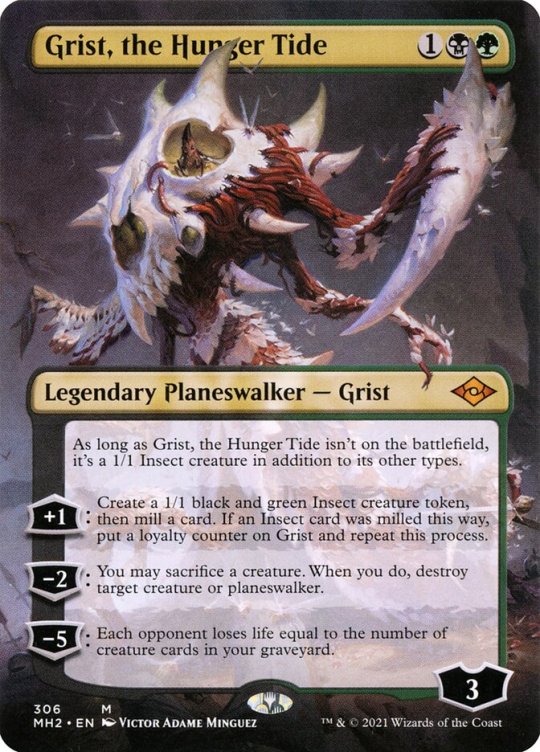

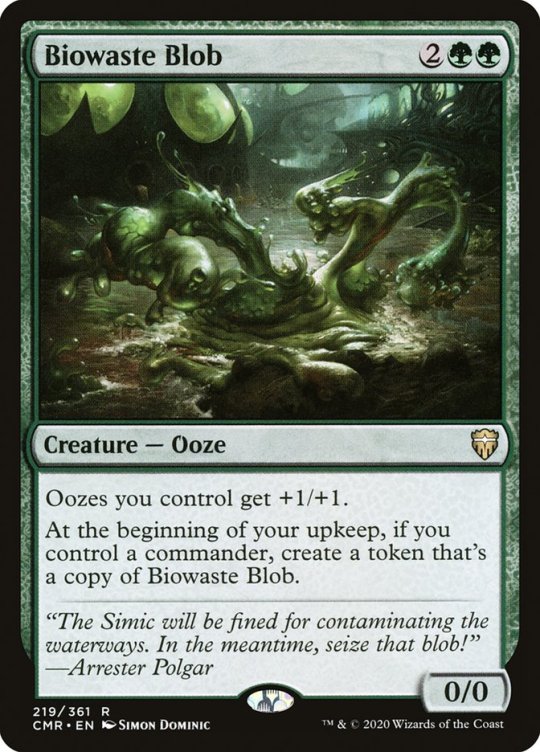
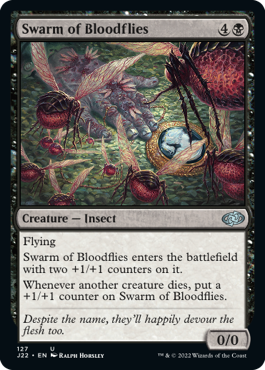
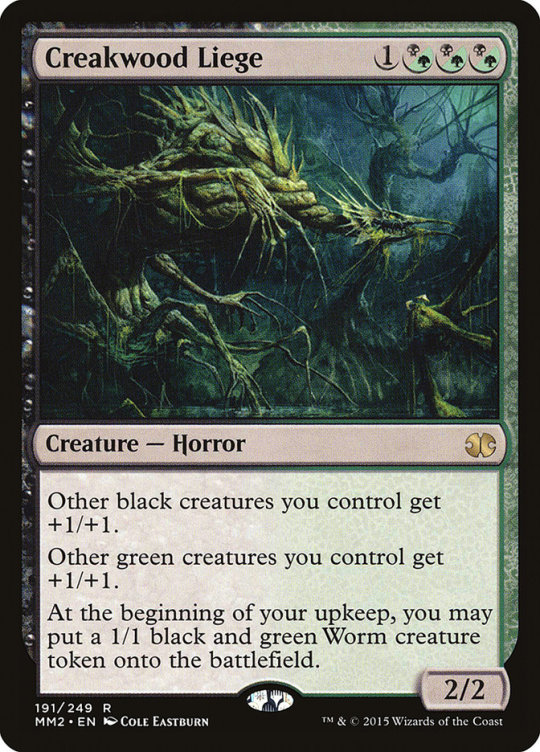
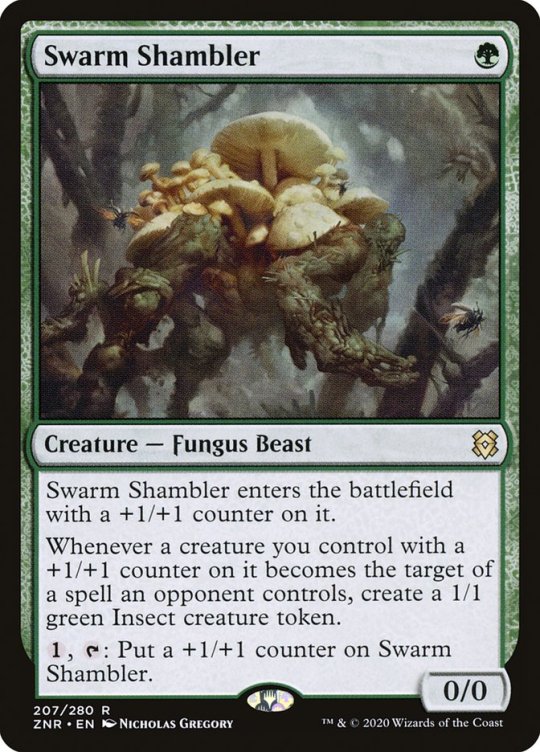
I still haven't played magic the gathering since my whole original collection and decks disappeared around 2006 but I'm now making my first ever commander deck (on a budget)
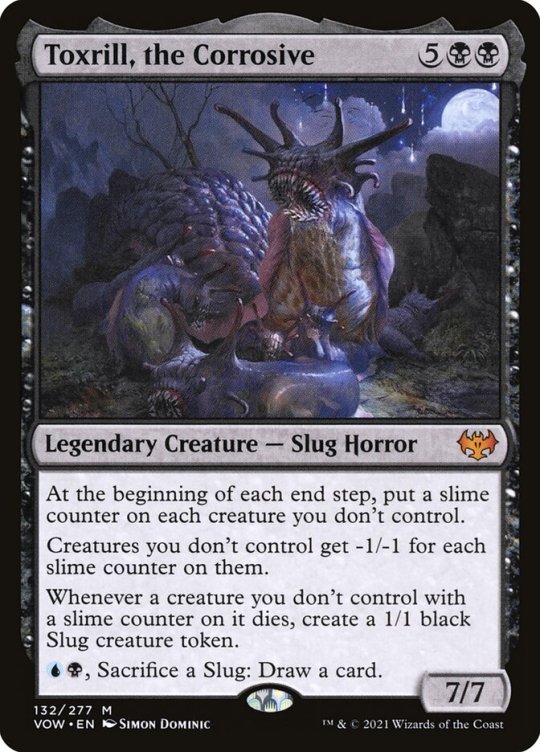
Just wish Toxrill the Corrosive used black and green mana instead of black and blue mana, it is very unfair they made a legendary slug who turns other people into slugs but if I used him for a commander deck I'd be locked out of a ton of other things I'd want to use (in Commander you pick a legendary creature to be your main guy but the rest of your deck has to be based on the main guy's mana colors)
Grist is pretty great though because this part is her real self:
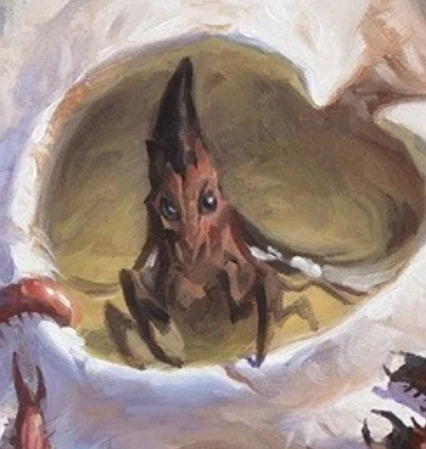
If there was a black, blue, and green legend I liked I could use both of them, maybe some day
#magic the gathering#mtg#mtg commander#I hope it's okay for me to randomly recommend cards for you#and also to make guesses about your aesthetic
208 notes
·
View notes